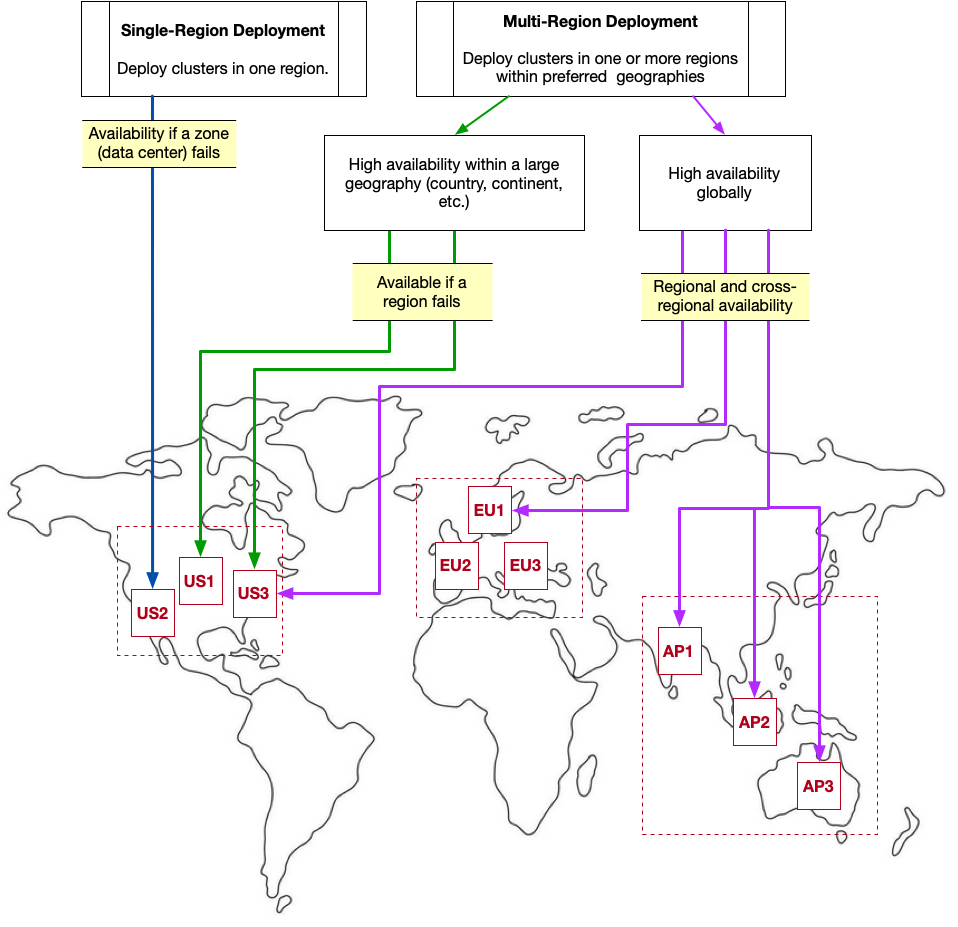Atlas Deployment Paradigms
When deploying your database, you have 2 main choices. The following diagram shows these options, which are explained further below:

This is the simplest deployment option. In a single-region deployment, your
data is stored in one of a provider's regions (such as AWS's us-west-2
or Google's asia-northeast3). With this simplicity and lower cost comes
the risk of lower availability and potentially lower latency, depending on the
distribution of your application's users. Atlas always provides a
minimum of zone-level availability, which means that within a single region, if
a single zone fails, your data is still available in the other zones.
This deployment paradigm provides a more robust option with higher availability. There are several types of multi-region deployments:
Deploying clusters to multiple regions hosted by a single cloud provider within a single "geography" (large areas like a continent or countries). For example, you deploy clusters in regions called
us-1andus-3, both of which are in the United States and are managed by the same cloud provider. This ensures availability if any given region fails.Deploying clusters to one or more regions in two or more geographies. For example, you deploy clusters in regions called
us-1andus-3, both of which are in the United States, and a third cluster ineu-2, which is in Europe. This ensures availability if any given region fails, or if an entire geographic area is unavailable.Deploying clusters to multiple regions hosted by multiple cloud providers. For example, you deploy clusters in the AWS region
us-west-1and the GCP regionus-east4. This provides the highest level of availability, ensuring your data is available even if an entire cloud provider fails.Global Cluster Deployment. This option should be considered for only the most complex situations; for example, where you need global aggregation of user data, or where legal terms dictate specific hosting requirements.
The following table provides a comparison of deployment paradigms to help you determine the best fit for your needs:
Design Consideration | Single-Region | Multi-Region in One Geography | Multi-Region in Multiple Geographies | Multi-Cloud |
|---|---|---|---|---|
Availability & Reliability | Data is available if a single zone (data center) fails | Data is available if a single region fails | Data is available if multiple regions or geographies fail | Data is available if a cloud provider fails |
Performance | High for regional users; lower for others | High for users within the chosen geography | High for users within all of the chosen geographies | High for users within all of the chosen geographies |
Complexity | Quick setup and easy maintenance | More complex than Single-Region | Same as Multi-region in 1 geography | More difficult, as it requires an account with each provider |
Security & Data Sovereignty | Data, by default, exists in a single location | Data resides in a single geographic region | You can partition the data so that certain data resides in specific regions. | You can partition the data so that certain data resides in specific regions, or even on a specific provider in a specific region. |
Note
The cost of each deployment type depends on several factors, including the provider(s) you select, the number of regions you need, the amount of storage, and the processing power of the servers. For the latest pricing information, refer to the MongoDB Pricing.